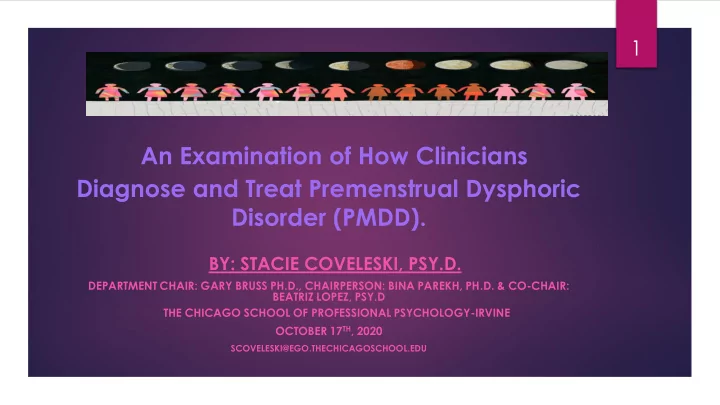

1 An Examination of How Clinicians Diagnose and Treat Premenstrual Dysphoric Disorder (PMDD). BY: STACIE COVELESKI, PSY.D. DEPARTMENT CHAIR: GARY BRUSS PH.D., CHAIRPERSON: BINA PAREKH, PH.D. & CO-CHAIR: BEATRIZ LOPEZ, PSY.D THE CHICAGO SCHOOL OF PROFESSIONAL PSYCHOLOGY-IRVINE OCTOBER 17 TH , 2020 SCOVELESKI@EGO.THECHICAGOSCHOOL.EDU
Abstract: PMDD, has unclear definitive explanations regarding its origins and mechanisms. No current validated objective assessment measures exist. Sixty-five licensed mental health clinicians were assessed on their ability to accurately diagnose a fictional vignette depicting PMDD. Rule-out diagnoses and treatment intervention recommendations were examined. Subjects were recruited via purposive convenience sampling using online platforms. Results indicate that almost half of participants (49%) provided a misdiagnosis. Female therapists were more likely to make an accurate diagnosis. Number of years licensed was not found to be correlated with accurate diagnosis. Further education/training on PMDD should be made available to students and clinicians internationally.
3 Results Based on Four Hypotheses: 1: Licensed mental health clinicians will misdiagnose a fictional clinical case vignette depicting PMDD. 2: Licensed mental health clinicians will recommend three wrong forms of treatment for the fictional patient. 3: Licensed mental health clinicians will list inappropriate rule-outs (including not listing PMDD if not an initial diagnosis in hypothesis 1) for the fictional patient. 4: Gender and years of practice of clinician will not be correlated to hypotheses 1, 2 and 3.
Results 4 Descriptive Statistics Demographics of Participants: The youngest age of participant (N=1) was 27 years-old, and the oldest age (N=1) was 76 years-old. Table I: Participant Age and Years of Practice: Factor Mean SD N Age 46.53 12.92 65 Years of Practice 12.02 11.30 65
5 Results Descriptive Statistics Table II: Type of Licensed Mental Health Clinician: Type of Clinician N % Ph.D. 22 34 LMFT 13 20 13 20 LCSW 19 12 Psy.D. 8 5 MD
6 Results: Figure 1: Primary Diagnosis Substance Use Disorder Personailty 1% Disorder Impulse Control 6% 11% Anxiety Disorder PMDD 5% 45% PMDD Bi-Polar Disorder (I &II) 12% Depressive Disorder 20%
7 Results: Figure 2: Rule-Out Diagnosis Other PMDD Personality Disorder 5% 11% 8% Substance Use Disorder 2% Impulse Control Disorder 14% Depressive Disorders Anxiety Disorders 35% 1% Bi-Polar Disorder (I & II) 24%
8 Results: Figure 3: First Treatment Choice Psychodynamic Refer to a Psychiatrist Psychotherapy 9% 6% 6% CBT Couples therapy 3% Mindfulness 13% Request a medical examination 63%
9 Results: Figure 4: Second Treatment Choice CBT 6% Psychodynamic Psychotherapy 17% Refer to a Psychiatrist 37% DBT 3% Couples Therapy 6% Request a Medical Mindfulness Examination 22% 9%
10 Results: Figure 5: Third Treatment Choice Psychodynamic Refer to a Psychiatrist Psychotherapy 11% DBT Request a Medical 8% 6% Examination 4% Couples Therapy 8% CBT 31% Mindfulness 32%
11 Chi-Square Test: As can be seen by the frequencies cross tabulated in Table III, there is a significant relationship between gender and accurate diagnosis of fictional client, X2 (2, N=65) =.01, p<. 05. Table III: Gender and Accurate Diagnosis: Gender PMDD Other Diagnosis N Male 4 13 17 Female 29 18 47 0 1 1 Other 33 32 65
12 Clinical Implications: This study should serve as a catalyst for increased research about how clinician’s gender may impact the diagnosis of PMDD. This research can add to the feminist theory within psychology because some men may unconsciously hold biases about women’s reproductive health which gets displayed as a hesitancy or lack of awareness around assessing for diagnoses like PMDD. Approximately half (49%) of participants in this study chose the inaccurate primary diagnosis for the fictional patient, which indicates that PMDD may not be imbedded into training/curriculum of accredited mental health masters or doctoral level programs. PMDD is a recently recognized illness (only considered six years prior to this study), and therefore, it could indicate that relevant academic programs may not be thoroughly or properly training students about the differences between the new DSM- 5 and it’s previous (DSM IV -TR) version.
Recommend
More recommend